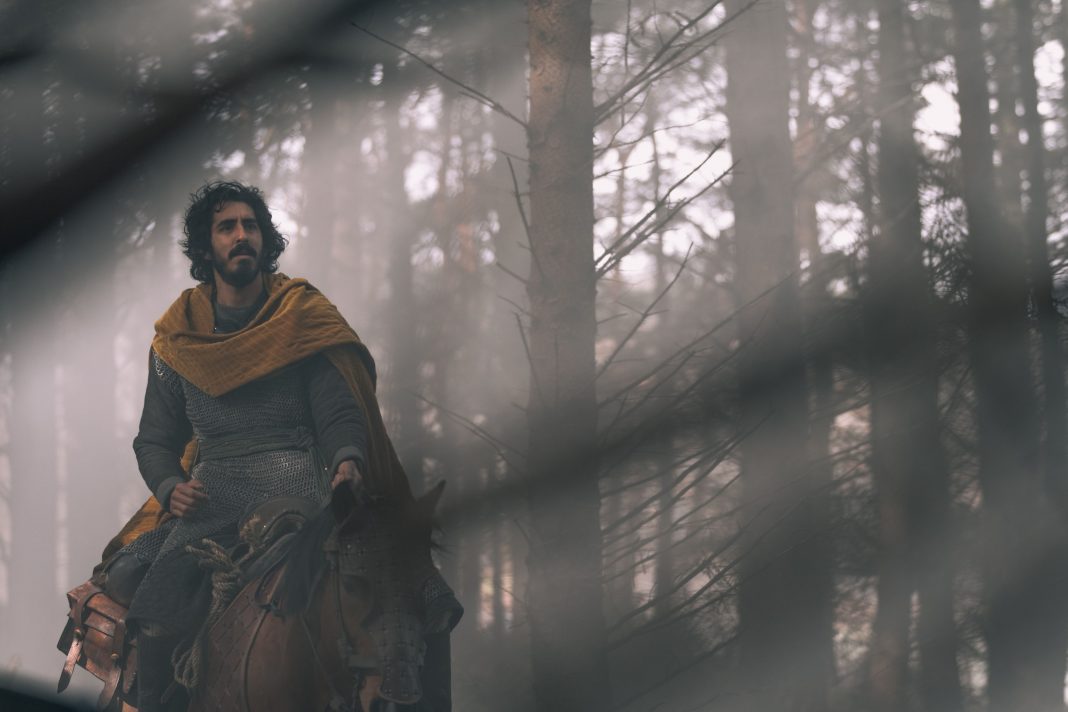A24 knows how to hype cinephiles about its films long before they hit the screen. Capitalizing on the recent popularity of old-school role-playing games, the studio crafted and released its own themed role-playing game in preparation for the release of The Green Knight. It was a cute marketing idea and in keeping with the fantasy theme of the movie. It also signals a very different kind of fantasy film experience from the one audiences will see this weekend. The Green Knight doesn’t feel like a straightforward action and adventure role-playing game; instead it feels more like a cinematic version of a tarot card reading.
To clarify two things: 1) no, I don’t actually know anything about tarot cards, and 2) yes, that’s a compliment.
I went into The Green Knight certain it couldn’t hold up to the hype and fervor surrounding the film, but I’m here to tell you it does. The Green Knight is based on an Arthurian legend a smidge less famous than the sword in the stone. But the supernatural, witchy elements of the film feel more akin to any one of A24’s modern horror flicks, like Midsommar or The Witch. Like that deck of tarot cards, The Green Knight takes its viewers on a journey of surreal visuals, stacking a series of other-worldly encounters in a seemingly random sequence. Puzzling out their underlying meanings is a huge part of the experience.
The Green Knight is a tale you may already be familiar with: it’s based on the 14th-century poem Sir Gawain and the Green Knight, which tells the story of how Sir Gawain became a renowned and respected knight of King Arthur’s Round Table.
The film opens with Gawain (Dev Patel) attending his uncle King Arthur’s (Sean Harris) Christmas celebrations while hung over from a night of drinking and gallivanting. During the festivities, the Green Knight (Ralph Ineson) rides into the dining hall and challenges any of the knights there to fight him. As part of the challenge, he warns that any blow he receives must be returned to his opponent 1 year later in exactly the same spot on their body – an eye for an eye, if you will. Gawain accepts and decapitates the Green Knight, who, to his horror, survives without his head and warns Gawain that he’ll see him next Christmas to return the favor.
While Gawain’s duel becomes a local legend, time swiftly returns him to December of the next year, where he must either make good on his word to let the Green Knight strike him or hide from his promise. Though reluctant, Gawain sets out on horse, aided by a mystical protection from his mother, Morgan Le Fay (Sarita Choudhury) that she insists will keep him safe. On his journey he encounters a wide range of obstacles, from fools to Kings, that he must overcome.
Writer and director David Lowery takes a story older than old, one tackled numerous times by other authors and mediums, and works a kind of magic to make it his own. The Green Knight reminded me in subtle ways of a lot of other films I’d seen – Darren Aronofksy’s The Fountain, Robert Eggers’ The Witch, even Jim Henson’s The Dark Crystal as just a few examples – while at the same time feeling unlike anything I’d seen before. Rather than bowing to traditional fantasy storytelling traditions, The Green Knight sets out to make new ones.
In addition to its originality in story and approach, part of The Green Knight’s magic is its technical craft, which employs strong elements of contrast across the board. The cinematography from Andrew Droz Palermo uses lush earth tones with splashes of vibrant lights to create a trance-like mood, and you could pluck one of any number of frames from the film and hang it on your wall. The sound design adds to that with a layer of earthy, rustic tones reminiscent of tree branches bending or wood breaking. Even the costume design stuck with me on this one, with several characters clad in clothing that mirrored the grain of wood, and others, such as Alicia Vikander’s Lady of the Castle, contradicting in vibrant jewel tones. Though this is Patel’s movie first and foremost – and he nails it – the craft of his supporting actors also lends to the atmosphere. Harris’s Arthur and Kate Dickie’s Queen Guinevere in particular create a strange feeling of battling duality, such that the King and Queen are both rotting and decayed figures of the past while feeling like warm and kind advisers.
Effusive praise aside, The Green Knight will absolutely not be for everyone. Clocking in at 130 minutes, the film moves at a slow, slow pace. Obscure fonts and voice effects sometimes make the film literally difficult to understand in additional to any intentionally ambiguity. And, again, viewers who go in expecting a more traditional sense of epic fantasy storytelling may be left wanting. The narrative also offers little in the traditional sense of adventure or battles you might expect from a knight’s story. It asks more questions than it’s willing to answer.
But still, The Green Knight rewards viewers’ patience and will stick with you long after the credits roll, particularly for those who are game to divine a greater meaning from its enigmatic offerings.









